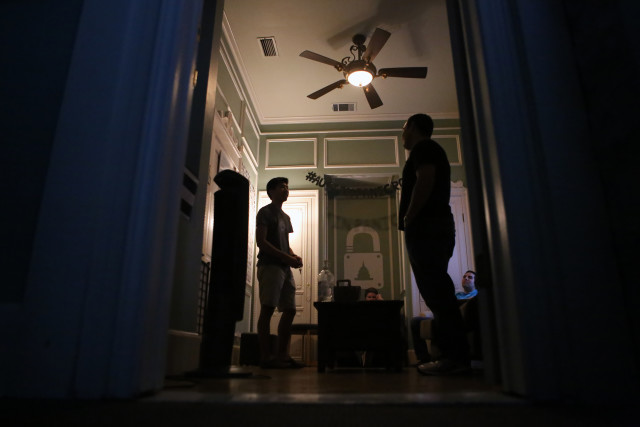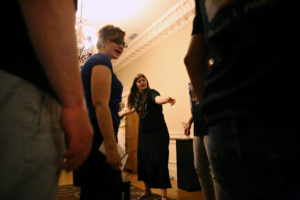No Escape: ‘Panic Rooms’ Are Popping Up Everywhere
By Megan Dolan
Reporting Texas and The Dallas Morning News

Stefan Tsai, an Austin Panic Room operator, preps a group for incarceration. Thalia Juarez/Reporting Texas
Inside a nondescript, gray downtown Austin building, people are working desperately to escape a room before their time runs out.
Austin Panic Room is part of a new type of entertainment experience, in which groups of four to 10 people are locked inside themed rooms and given a story line, objective and a few clues. They have one hour to escape. The rooms are designed around themes that range from horror zombie rooms to abandoned schoolhouses to prison breaks.
Austin Panic Room started in East Austin in September 2014 and moved to Rio Grande Street this past April. That same month, the owners expanded to San Antonio, and a Dallas location opened this month. At the same time, Dallas-based Escape Expert plans to expand to Austin, San Antonio and Houston.
Since the Austin Panic Room opened, about 25,000 people have visited, and the rooms are booked 75 percent of the time. Yet marketing manager Molly Sun, 26, said the industry remains a novelty in the U.S.
“The basic gist is that you decide on a theme and a mission that people can accomplish, and then you want to plan out a network of different paths that you can take to ultimately get to the end result,” Sun said, explaining how the company designs the rooms. “Once we figure out that spider web, then we think about clues.”
Once the logistics are worked out, the company builds the room, beta tests it and train employees. During the game play, an operator monitors a group’s progress through security cameras and can communicate via a walkie-talkie. He may warn the group that time is running out or make a suggestion if they are getting close to solving the escape puzzle. The entrance isn’t locked in case a player gets claustrophobic or there’s an emergency.
Escape rooms are spreading across the country, including in Dallas, San Antonio and Houston.
Dan Egnor, 41, a computer programmer and escape room fan in Palo Alto, Calif., said escape rooms first appeared in Japan and Hungary in 2008, with the first U.S. location opening in 2013 in San Francisco.
Once Egnor discovered escape rooms, he was hooked.
“I organized an escape crawl where a bunch of us tried to do as many escape rooms as we could in one day, which at the time was all the escape rooms we could find in the area, and we did six,” Egnor said. “At the time, it was remarkable.”
Egnor’s desire to find more escape rooms led him to create Escaperoomdirectory.com, which lists 2,595 rooms in 60 countries. He adds about 20 listings a week, half of them in the U.S.
Mitchell Wright, 27, a family doctor in the Canadian capital of Ottawa, has done every escape room in his city and runs Escape Reviewer on the side with his brother. Wright said his website lists 474 companies and more than 1,260 rooms. He said that the escape room industry shows no signs of slowing.
“It’s just becoming exponentially more popular as time goes on,” Wright said.
Lisa Radding, 29, and David Spira, 30, run Room Escape Artist from Weehawken, N.J. Radding is the director of research and product development at Ethnic Technologies, and Spira is the user experience designer with Phase2, but their blog has quickly become a side job.
“The growth in the States is shockingly fast, and much of the world had a big head start,” Spira said.
“They tend to pop up next to each other in little pockets,” Radding added. “As soon as a city gets one, they have four.” Since Austin Panic Room set up shop, four competitors have opened, such as the Great Room Escape Austin near the former Highland Mall and Puzzle Room Austin on West Anderson Lane.

Julie O’Brien, a visitor from Los Angeles, points out a clue to friends and family during a recent Panic Room outing. Thalia Juarez/Reporting Texas
Wright has developed an app based on his website. The Escape Reviewer launched in early November and allows users to find escape rooms and rate them. It’s available in Apple’s App Store.
“I would say the most similar thing to it is Trip Advisor, just for escape rooms,” Wright said. “There are still so many people who don’t know about them.”
According to a study in May by Scott Nicholson, a professor at Wilfrid Laurier University in Canada, businesses make up about 19 percent of escape room customers. At Austin Panic Room, 60 percent of customers are there on company events, Sun said.
Recently, Mark Rinker led a group of work colleagues through an art-museum themed room at Austin Panic Room. He declined to name their company or give his age.
Seventy percent of customers take more than an hour to find the escape, Sun said. Rinker’s group did it with a few minutes to spare. A large part of their success was working as a team, something that makes escape rooms attractive for business team-building events.
Despite the growth, some have doubts about the industry.
“Next year, are these all going to be gone, and everyone will have gotten tired of it?’” Egnor asked. “That’s the big question that everyone’s making guesses about.”
Wright shakes off the skepticism.
“Back in 1987, they said video games were going to be a fad,” Wright said. “It’s one of the most popular types of entertainment right now.”
Spira is optimistic.
“They’ll all help each other grow,” he said. “These companies, even if they operate within a mile or two of each other, they’re not necessarily in direct competition with each other, because people who will have a good time in these will want to play more.”
Austin Panic Room recenlty opened a new room, called Prison Break, at its downtown location. The company changes the room themes every six to eight months, a process that costs about $5,000.
“We’re rebranding ourselves as Texas Panic Room because we want to differentiate ourselves from other competitors,” Sun said. “We started in Texas, we’re run by Texans and we’re Texas’s panic room, and we love being here.”